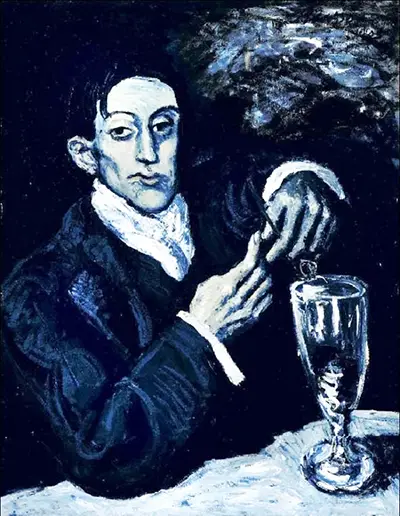During his career, Picasso is said to have produced about 20,000 master pieces that included prints, sketches, theater sets, paintings, sculptures as well as ceramics that all highlighted is a virtuoso on a variety of art mediums. Despite, his numerous work there are a number of his pieces that stand out one of which is the portrait of Angel Fernandez de Sato. The Portrait of Angel Fernández de Soto in some instance known as The Absinthe Drinker was completed in 1903 during Picasso's blue period. The painting is primarily of a Picasso's friend and fellow artist Angel Fernandez de Soto who is seated in a bar enjoying a glass of absinthe. The portrait became increasingly famous in 2010 after it was sold for £34.7 million in an auction. The artistic genius of Picasso in reference to the Absinthe Drinker portrait is based on how he brings in significant depth by not only using is minimalist skills but a contrast of dark and bright colours.
The creativity in this piece highlights the best of how Picasso realism and abstraction, Cubism, Surrealism, as well as Expressionism. The shades of grey and white on Fernández de Soto's face is natural bringing life to the photo from the dark almost black background. This is one of the focal points of the portrait. The style is replicated on the glass of absinthe. Nonetheless, the style used on the glass might be argued as expressionism considering the patterns used to give more detail, just as the folds on the coat that gives added depth. Picasso employs his world famous cubism style when bringing texture on the coat. This can similarly can be identified on the top right background bringing in a unique display of contrast that to this day remains unparalleled.
Most of Pablo Picassos painting that depicts Surrealism are primarily based on the use of a number of colour shades. For example, the Old Guitarist of 1904, portrait of Suzanne Bloch portrait of Gertrude Stein, Garcon a la pipe 1905 or Femme aux Bras Croises all unlock the power of imagination through a surrealism defined by colours and shades, none, can be as powerful as that used in the portrait of Angel Fernández de Soto. For example, Fernández de Soto's hands though out of proportion have been displayed in a way that they not only express great artistry but also emotion. He seems, anxious or caught in the moment. The same can be said of his facial expression as well as his pose.
Angel Fernández de Soto is said to be one of Picasso's closest friends as well as confidant. The two had briefly known each other during their time at Edèn Concert of the arrer Nou; however, it was until they shared a studio at Riera de Sant Joan as well as their social lifestyles made them close at Quatre Gats really make them more as brothers. This friendship grew until Sato's death in 1937. During their time together Picasso immortalized him in a variety of sketches as well as paintings but the 1903 portrait was special. Sato is styled in a manner that gave him elegance as well as a little bit of 'dandy' at the same instance. This was an ironical perception in reference to the other images he had presented of Sat such as the brothers Mateu and Àngel Fernández de Soto, with Anita. Barcelona, 1902-1903 or Àngel Fernández de Soto with a woman. Barcelona, 1902-1903. The portrait is argued to be how Picasso saw his friend when they were together away from all the drama of the night.

